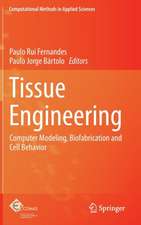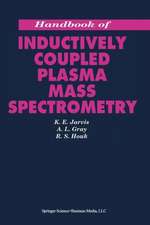Ultra Low-Power Biomedical Signal Processing: An Analog Wavelet Filter Approach for Pacemakers: Analog Circuits and Signal Processing
Autor Sandro Augusto Pavlik Haddad, Wouter A. Serdijnen Limba Engleză Paperback – 28 oct 2010
In Ultra Low-Power Biomedical Signal Processing we present a novel method for implementing signal processing based on WT in an analog way. The methodology presented focuses on the development of ultra low-power analog integrated circuits that implement the required signal processing, taking into account the limitations imposed by an implantable device.
| Toate formatele și edițiile | Preț | Express |
|---|---|---|
| Paperback (1) | 712.09 lei 43-57 zile | |
| SPRINGER NETHERLANDS – 28 oct 2010 | 712.09 lei 43-57 zile | |
| Hardback (1) | 719.02 lei 43-57 zile | |
| SPRINGER NETHERLANDS – 30 apr 2009 | 719.02 lei 43-57 zile |
Din seria Analog Circuits and Signal Processing
- 5%
 Preț: 902.97 lei
Preț: 902.97 lei - 9%
 Preț: 628.98 lei
Preț: 628.98 lei -
 Preț: 388.34 lei
Preț: 388.34 lei - 15%
 Preț: 636.30 lei
Preț: 636.30 lei - 15%
 Preț: 636.80 lei
Preț: 636.80 lei - 18%
 Preț: 941.82 lei
Preț: 941.82 lei - 15%
 Preț: 639.08 lei
Preț: 639.08 lei - 18%
 Preț: 918.48 lei
Preț: 918.48 lei - 15%
 Preț: 631.21 lei
Preț: 631.21 lei - 15%
 Preț: 642.03 lei
Preț: 642.03 lei - 15%
 Preț: 641.85 lei
Preț: 641.85 lei - 18%
 Preț: 887.05 lei
Preț: 887.05 lei - 18%
 Preț: 944.51 lei
Preț: 944.51 lei - 15%
 Preț: 632.55 lei
Preț: 632.55 lei - 15%
 Preț: 641.03 lei
Preț: 641.03 lei - 18%
 Preț: 836.39 lei
Preț: 836.39 lei - 15%
 Preț: 642.18 lei
Preț: 642.18 lei - 15%
 Preț: 639.90 lei
Preț: 639.90 lei - 18%
 Preț: 947.85 lei
Preț: 947.85 lei - 15%
 Preț: 642.51 lei
Preț: 642.51 lei - 15%
 Preț: 631.86 lei
Preț: 631.86 lei - 15%
 Preț: 634.49 lei
Preț: 634.49 lei - 15%
 Preț: 635.47 lei
Preț: 635.47 lei - 15%
 Preț: 640.06 lei
Preț: 640.06 lei - 15%
 Preț: 631.53 lei
Preț: 631.53 lei - 15%
 Preț: 635.65 lei
Preț: 635.65 lei - 18%
 Preț: 941.50 lei
Preț: 941.50 lei - 18%
 Preț: 1112.92 lei
Preț: 1112.92 lei - 15%
 Preț: 636.30 lei
Preț: 636.30 lei - 15%
 Preț: 633.19 lei
Preț: 633.19 lei - 15%
 Preț: 635.80 lei
Preț: 635.80 lei - 18%
 Preț: 888.01 lei
Preț: 888.01 lei - 18%
 Preț: 942.76 lei
Preț: 942.76 lei - 18%
 Preț: 1387.10 lei
Preț: 1387.10 lei - 18%
 Preț: 1115.28 lei
Preț: 1115.28 lei - 15%
 Preț: 633.68 lei
Preț: 633.68 lei - 15%
 Preț: 641.03 lei
Preț: 641.03 lei - 15%
 Preț: 638.57 lei
Preț: 638.57 lei - 15%
 Preț: 642.51 lei
Preț: 642.51 lei - 18%
 Preț: 947.85 lei
Preț: 947.85 lei - 15%
 Preț: 640.71 lei
Preț: 640.71 lei - 15%
 Preț: 640.88 lei
Preț: 640.88 lei - 15%
 Preț: 631.40 lei
Preț: 631.40 lei - 18%
 Preț: 944.19 lei
Preț: 944.19 lei - 18%
 Preț: 944.67 lei
Preț: 944.67 lei - 18%
 Preț: 942.94 lei
Preț: 942.94 lei - 15%
 Preț: 641.20 lei
Preț: 641.20 lei - 20%
 Preț: 555.52 lei
Preț: 555.52 lei - 18%
 Preț: 1003.38 lei
Preț: 1003.38 lei
Preț: 712.09 lei
Preț vechi: 749.56 lei
-5% Nou
Puncte Express: 1068
Preț estimativ în valută:
136.27€ • 141.41$ • 113.90£
136.27€ • 141.41$ • 113.90£
Carte tipărită la comandă
Livrare economică 17-31 martie
Preluare comenzi: 021 569.72.76
Specificații
ISBN-13: 9789048180615
ISBN-10: 9048180619
Pagini: 228
Ilustrații: X, 215 p.
Dimensiuni: 155 x 235 x 12 mm
Greutate: 0.33 kg
Ediția:Softcover reprint of hardcover 1st ed. 2009
Editura: SPRINGER NETHERLANDS
Colecția Springer
Seria Analog Circuits and Signal Processing
Locul publicării:Dordrecht, Netherlands
ISBN-10: 9048180619
Pagini: 228
Ilustrații: X, 215 p.
Dimensiuni: 155 x 235 x 12 mm
Greutate: 0.33 kg
Ediția:Softcover reprint of hardcover 1st ed. 2009
Editura: SPRINGER NETHERLANDS
Colecția Springer
Seria Analog Circuits and Signal Processing
Locul publicării:Dordrecht, Netherlands
Public țintă
ResearchCuprins
The Evolution of Pacemakers: An Electronics Perspective.- Wavelet versus Fourier Analysis.- Analog Wavelet Filters: The Need for Approximation.- Optimal State Space Descriptions.- Ultra Low-Power Integrator Designs.- Ultra Low-Power Biomedical System Designs.- Conclusions and Future Research.
Textul de pe ultima copertă
Ultra Low-Power Biomedical Signal Processing describes signal processing methodologies and analog integrated circuit techniques for low-power biomedical systems. Physiological signals, such as the electrocardiogram (ECG), the electrocorticogram (ECoG), the electroencephalogram (EEG) and the electromyogram (EMG) are mostly non-stationary. The main difficulty in dealing with biomedical signal processing is that the information of interest is often a combination of features that are well localized temporally (e.g., spikes) and others that are more diffuse (e.g., small oscillations). This requires the use of analysis methods sufficiently versatile to handle events that can be at opposite extremes in terms of their time-frequency localization.
Wavelet Transform (WT) has been extensively used in biomedical signal processing, mainly due to the versatility of the wavelet tools. The WT has been shown to be a very efficient tool for local analysis of non-stationary and fast transient signals due to its good estimation of time and frequency (scale) localizations. Being a multi-scale analysis technique, it offers the possibility of selective noise filtering and reliable parameter estimation.
Often WT systems employ the discrete wavelet transform, implemented on a digital signal processor. However, in ultra low-power applications such as biomedical implantable devices, it is not suitable to implement the WT by means of digital circuitry due to the relatively high power consumption associated with the required A/D converter. Low-power analog realization of the wavelet transform enables its application in vivo, e.g. in pacemakers, where the wavelet transform provides a means to extremely reliable cardiac signal detection.
In Ultra Low-Power Biomedical Signal Processing we present a novel method for implementing signal processing based on WT in an analog way. The methodology presented focuses on the development of ultra low-power analog integrated circuits that implement the required signal processing, taking into account the limitations imposed by an implantable device.
Wavelet Transform (WT) has been extensively used in biomedical signal processing, mainly due to the versatility of the wavelet tools. The WT has been shown to be a very efficient tool for local analysis of non-stationary and fast transient signals due to its good estimation of time and frequency (scale) localizations. Being a multi-scale analysis technique, it offers the possibility of selective noise filtering and reliable parameter estimation.
Often WT systems employ the discrete wavelet transform, implemented on a digital signal processor. However, in ultra low-power applications such as biomedical implantable devices, it is not suitable to implement the WT by means of digital circuitry due to the relatively high power consumption associated with the required A/D converter. Low-power analog realization of the wavelet transform enables its application in vivo, e.g. in pacemakers, where the wavelet transform provides a means to extremely reliable cardiac signal detection.
In Ultra Low-Power Biomedical Signal Processing we present a novel method for implementing signal processing based on WT in an analog way. The methodology presented focuses on the development of ultra low-power analog integrated circuits that implement the required signal processing, taking into account the limitations imposed by an implantable device.
Caracteristici
Offers a structured approach to filter design, starting from an arbitrary transfer function or impulse response, all the way down to the actual circuit design Concentrates on low-power design at all the hierarchical design levels involved, viz. of the transfer function, of the topology and of the circuit; at all levels the results are verified and put into perspective Provides an overview of the history and development of cardiac pacemakers, the first implantable biomedical electronic device and an outlook to future devices Bridges the gap between the mathematics domain and the electronics domain Includes supplementary material: sn.pub/extras
























